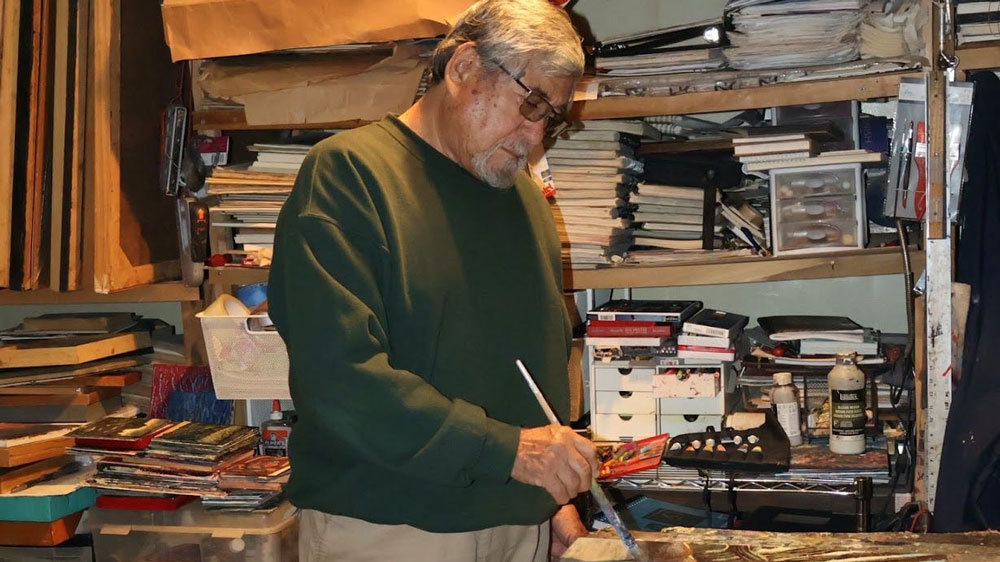Raul Servin came to San Antonio from Acapulco, Mexico in 1968 as an artist hired to decorate the large platform utilized by the Mexican Voladores de Papantla in HemisFair 68. After HemisFair closed, Servin returned to Acapulco, Mexico but found his way back to San Antonio the following year to start a new life. For the past forty years, he has been a major contributor to the Mexican and Chicano art community of San Antonio.
Servin grew up in Ixcapuzalco, a small rural community of less than 500 residents in the state of Guerrero midway between Mexico City and Acapulco on the Pacific coast. When he was a toddler, his family left him in Ixcapuzalco to live with his grandmother Maria Acencion Vasquez, known to her family and neighbors as “Chonita.” His grandmother was raised in an indigenous culture and spoke Spanish as well as her native languages of Nahuatl and Zapotec. She cared for Servin and an ailing family member across the road. In return for her services, the family gave them food.
Until age ten when Servin left the small village, the young boy helped his grandmother in her volunteer chores, principally in gathering stones for a new community Catholic church. Daily, young Servin and “Chonita” went with their donkey to collect stones from the riverbed and surrounding hills needed for the church walls. The young boy also helped his grandmother harvest herbs she prescribed to those needing folk medicinal supplements. The memory of the rustic environment and agricultural workers would one day be the subject of many of his artworks.
Servin’s parents moved to Acapulco, and at age seven he joined them. The young boy enrolled in art classes offered through the Mexican government’s sponsored Instituto Nacional Bellas Artes, a program to encourage the development of young artists throughout the country. Servin excelled in the fine arts program, and at age sixteen he began exhibiting his artwork. The following year, he became a founding member of a local art organization known as El Jardin de Arte de Acapulco. Servin took art seriously. He enrolled in Pre-Colombian art classes and served as an art instructor at a local junior high school.
Servin’s first career break came in the late 1960s when he landed a job in Acapulco painting the
performance stage for the Voladores de Papantla. [Known outside of Mexico as the Flying Indians]. The Mexican company that hired him also had a contract to build and decorate the stage at the new HemisFair68 in San Antonio. In the Spring of 1968, Servin traveled with the Acapulco company to San Antonio. A series of events
during his stay in San Antonio dramatically altered his artistic career path.
Mexico was one of the few Central and Latin American countries engaged in HemisFair. The Mexican government’s participation included the Voladores, musicians, and folkloric dancers. By the end of HemisFair in the fall of 1968, Servin had applied his decorative art skills to assist most of Mexico’s exhibitors. During this brief stay, he also met a young Latina from San Antonio and they married. Servin returned briefly to Acapulco with his new wife but they relocated permanently to San Antonio the following year.
In Servin’s first years in San Antonio, he put aside his art career and devoted his time to supporting his family. When his children reached their teen years, Servin enrolled in art classes at San Antonio Community College studying primarily with art professors Felipe Reyes and Mel Casas. He developed greater artistic skills, and over the next forty years, Servin exhibited his art with Joe Lopez Gallista Gallery, Centro Cultural Aztlan, and other venues
Servin’s training under San Antonio art professors Felipe Reyes and Mel Casas guided him in the application of color and encouraged him to pay close attention to line and depth. He also credits both professors for giving him important insights about the Chicano struggle in Texas and beyond. These insights led him to paint as a social and political activist. A recent painting shows a 19th-century slave owner whipping a bonded Black man with the image of the Alamo in the background. Slavery, this painting tells us, was a major cause of the Texas Revolution.
In his artist statement, Servin notes that his work “is self-defined by the principles of reality, identity, pride, struggle, pain, and destiny.” While Servin draws upon his memory of Mexico in multiple colorful landscapes, he is also influenced by physical existence, or what he considers reality. He has an infatuation for nopales [cacti]. He carefully cares for many varieties of cacti on his covered front porch and numerous others in a spacious greenhouse in the backyard. Several of his landscape paintings place nopales front and center with high mountain ranges in the background common to the interior of Mexico.
Servin incorporates Mexican history in his work as evidenced by his painting dedicated to the Treaty of
Guadalupe Hidalgo, the peace treaty that ended the U.S.-Mexico War of 1846-1848. History, Servin believes, teaches us about identity, struggle, and destiny. He has devoted dozens of his paintings to the Virgin Guadalupe which also address a Mexican sense of identity and pride.
Although Servin paints largely about the Chicano experience, he is fully aware of the larger “anguish and struggles” of people of color in American society. He keeps numerous sketchbooks of carefully detailed themed drawings done with graphite and colored pencils. In the aftermath of the George Floyd murder by Minnesota police officers, Servin drew and painted images of police brutality and racism. During the Pandemic era 2020-2022, Servin turned his attention to health issues, acknowledging the difficult work of healthcare providers and the reality that death came for many who were unaware or foolishly unwilling to take COVID-19 vaccines.
A large number of Servin’s paintings incorporate calaveras [skulls] and human skeletons as both a tribute to the early 20th-century Mexican master, Jose Guadalupe Posada, and Posada’s interpretation of identity and class. Servin explained that the recurring images of calaveras in his work are an “effort to erase prejudice of race, color, nationality, and gender, making everybody equal.”
Raul Servin: Artistic Chronicler of Mexican Rural Life and Chicano History and Culture












